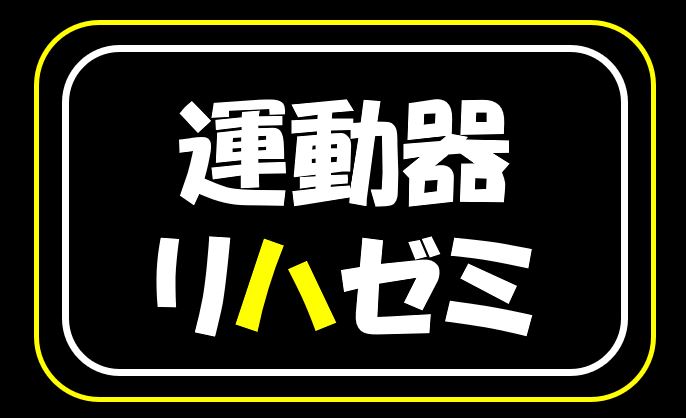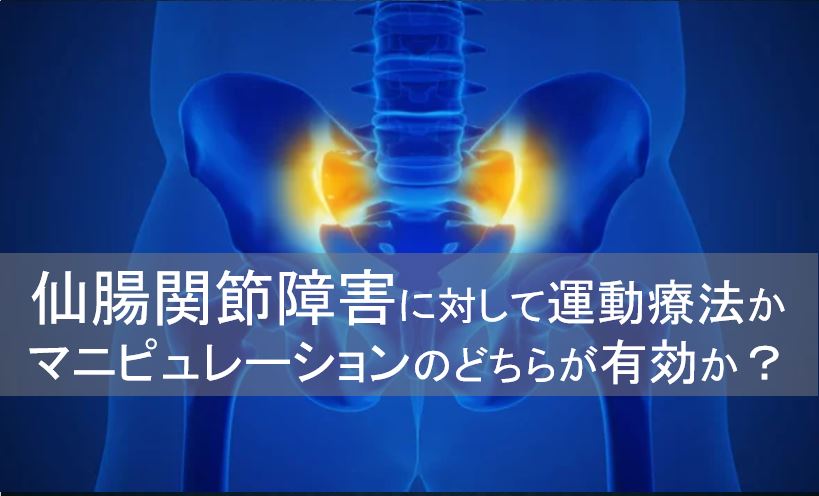こんにちは!
運動器専門のリハビリスタッフです!!
いつもお世話になります。
今回は、『仙腸関節障害に対して運動療法かマニピュレーションのどちらが有効か?』
について解説させていただきます。
仙腸関節は仙骨と腸骨で構成される関節です。
仙腸関節障害は非特異的腰痛(画像が難しい腰痛)であり急性腰痛症(いわゆるぎっくり腰)の原因の一つであるとされています。
仙腸関節障害は、1905年にGoldthwaitが提唱しており、外傷や感染症などによる明らかな関節破壊を伴わない仙腸関節由来の痛みとしております。
また、MRやCT画像で仙腸関節の機能障害を示す特異的な所見を捉えることは困難(Bernard TN Jr.1991)と報告されています。
腰痛に占める仙腸関節性腰痛の頻度は3.5~30%との報告があるが、村上の1年間調査では504例中54例(10.7%)であった(村上.2010)とされています。
そんな中、2019年に、仙腸関節障害に対して運動療法かマニピュレーションのどちらが有効かを検証した論文が海外で報告されております。
この論文の検証結果が気になるところです。
◆論文紹介
Randomized Controlled Trial
. 2019 Jan;22(1):53-61.
Effectiveness of Exercise Therapy and Manipulation on Sacroiliac Joint Dysfunction: A Randomized Controlled Trial
仙腸関節機能障害に対する運動療法とマニピュレーションの有効性: 無作為化対照試験
Parisa Nejati 1, Afsaneh Safarcherati 1, Farshid Karimi 1
Affiliations expand
- PMID: 30700068
Free article
Abstract
Background: The sacroiliac joint dysfunction (SIJD) has been found to be the primary culprit for lower back pain (LBP), but it is still overlooked and treated as LBP. There are no guidelines or appropriate therapeutic protocols for SIJD. Thus, there is a need for an effective treatment strategy for SIJD.
概要
背景 仙腸関節機能障害(SIJD)は腰痛(LBP)の主原因であることが判明しているが、未だに見過ごされ、LBPとして扱われているのが現状である。SIJDに対するガイドラインや適切な治療プロトコルは存在しない。したがって、SIJDの効果的な治療戦略が必要である。
Objective: To compare exercise therapy (ET), manipulation therapy (MT), and a combination of the 2 (EMT) in terms of their effectiveness in treating SIJD.
目的 SIJDの治療法として、運動療法(ET)、マニピュレーション療法(MT)、および両者の併用療法(EMT)を比較検討すること。
Study design: A comparative, prospective, single-blind randomized controlled trial .
研究デザイン 比較プロスペクティブ単盲検無作為化比較試験。
Setting: Sports Medicine Department of Rasoul Akram Hospital.
セッティング Rasoul Akram 病院のスポーツ医学部。
Methods: A total of 51 patients with lower back or buttock pain resulting from SIJD were randomly assigned to 1 of 3 study groups: ET, MT, or EMT. The ET group received posterior innominate self-mobilization, sacroiliac joint stretching, and spinal stabilization exercises. The MT group underwent posterior innominate mobilization and SIJ manipulation. Lastly, the EMT group received manipulation maneuvers followed by exercise therapy. Pain and disability were assessed at 6, 12, and 24 weeks after the interventions.
Results: All 3 groups demonstrated significant improvement in pain and disability scores compared to the baseline (P < 0.05). The difference among these therapeutic protocols was found to be a function of time. At week 6, MT showed notable results, but at week 12, the effect of ET was remarkable. Finally, at week 24, no significant difference was observed among the study groups.
結果 3群ともベースラインと比較して、痛みと障害のスコアに有意な改善を示した(P < 0.05)。これらの治療プロトコール間の差は時間の関数であることが判明した。6週目ではMTが顕著な効果を示したが、12週目ではETの効果が顕著であった。最終的に、24週目では、研究グループ間で有意差は認められなかった。
Limitations: A major limitation of the present study is lack of a control group receiving a type of intervention other than the experimental protocols. Another limitation is the short duration of follow-ups.
制限事項 本研究の主要な限界は、実験プロトコル以外のタイプの介入を受けた対照群を欠いていることである。もう一つの限界は、フォローアップの期間が短いことである。
◆論文の結論
Conclusions: Exercise and manipulation therapy appear to be effective in reducing pain and disability in patients with SIJD. However, the combination of these 2 therapies does not seem to bring about significantly better therapeutic results than either approach implemented separately.
結論 運動療法とマニピュレーション療法は、SIJD患者の痛みと障害を軽減するのに有効であるように思われる。しかし、これら2つの療法の併用は、どちらかのアプローチを単独で実施した場合に比べ、有意に良好な治療結果をもたらさないようである。
◆まとめ
上記論文では仙腸関節機能障害(SIJD)に起因する腰痛または殿部痛を有する患者51名を運動療法群(ET)、マニピュレーション群(MT)、両者の併用群(EMT)の3つの群に振り分け、治療効果を検討しております。
運動療法群(ET)では、寛骨後方セルフエクササイズ、仙腸関節ストレッチ、脊椎安定化運動を実施しており。マニピュレーション療法群(MT)では、寛骨後方のモビライゼーションと仙腸関節マニピュレーションを行っております。
介入後6、12、24週目に痛みと障害が評価されているようです。
結果として、3群ともに介入前と比較して、痛みと障害のスコアは有意に改善しているようです。
また、介入6週目ではマニピュレーション群が顕著な効果を示し、介入12週目では運動療法群の効果が顕著であったとのことです。
最終的に、24週目では、研究グループ間で有意差は認められなかったようです。
上記論文の結果を踏まえると、仙腸関節機能障害(SIJD)に起因する腰痛または殿部痛に対して、運動療法やマニピュレーション療法は有効であるようです。
しかし、両者を併用したことによる相乗効果が生じるということはないようです。
今回は、『仙腸関節障害に対して運動療法かマニピュレーションのどちらが有効か?』
について解説させていただきました。


![[商品価格に関しましては、リンクが作成された時点と現時点で情報が変更されている場合がございます。] [商品価格に関しましては、リンクが作成された時点と現時点で情報が変更されている場合がございます。]](https://hbb.afl.rakuten.co.jp/hgb/1f7a7439.6deab8a7.1f7a743a.315603be/?me_id=1213310&item_id=21251977&pc=https%3A%2F%2Fthumbnail.image.rakuten.co.jp%2F%400_mall%2Fbook%2Fcabinet%2F7457%2F9784524227457_1_4.jpg%3F_ex%3D240x240&s=240x240&t=picttext)


